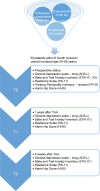Psychological factors as risk factors for poor hip function after total hip arthroplasty
- PMID: 28260910
- PMCID: PMC5328130
- DOI: 10.2147/TCRM.S127868
Psychological factors as risk factors for poor hip function after total hip arthroplasty
Abstract
Recovery after total hip arthroplasty (THA) is influenced by several psychological aspects, such as depression, anxiety, resilience, and personality traits. We hypothesized that preoperative depression impedes early functional outcome after THA (primary outcome measure). Additional objectives were perioperative changes in the psychological status and their influence on perioperative outcome. This observational study analyzed depression, anxiety, resilience, and personality traits in 50 patients after primary unilateral THA. Hip functionality was measured by means of the Harris Hip Score. Depression, state anxiety, and resilience were evaluated preoperatively as well as 1 and 5 weeks postoperatively. Trait anxiety and personality traits were measured once preoperatively. Patients with low depression and anxiety levels had significantly better outcomes with respect to early hip functionality. Resilience and personality traits did not relate to hip functionality. Depression and state anxiety levels significantly decreased within the 5-week stay in the acute and rehabilitation clinic, whereas resilience remained at the same level. Our study suggests that low depression and anxiety levels are positively related to early functionality after THA. Therefore, perioperative measurements of these factors seem to be useful to provide the best support for patients with risk factors.
Keywords: depression; personality traits; psychological factors; resilience; state anxiety; total hip arthroplasty; trait anxiety.
Conflict of interest statement
Disclosure The authors report no conflicts of interest in this work.
Figures



Similar articles
-
Anxiety and depressive symptoms before and after total hip and knee arthroplasty: a prospective multicentre study.Osteoarthritis Cartilage. 2013 Dec;21(12):1834-40. doi: 10.1016/j.joca.2013.08.022. Epub 2013 Sep 4. Osteoarthritis Cartilage. 2013. PMID: 24012622
-
Changes in Anxiety and Depression After THA in Patients with Ankylosing Spondylitis and the Affecting Factors.Ther Clin Risk Manag. 2023 Aug 15;19:675-684. doi: 10.2147/TCRM.S415564. eCollection 2023. Ther Clin Risk Manag. 2023. PMID: 37601141 Free PMC article.
-
Depression and anxiety before and after limb length discrepancy correction in patients with unilateral developmental dysplasia of the hip.J Psychosom Res. 2015 Dec;79(6):574-9. doi: 10.1016/j.jpsychores.2015.08.002. Epub 2015 Aug 8. J Psychosom Res. 2015. PMID: 26303390
-
Results of total joint arthroplasty and joint preserving surgery in younger patients evaluated by alternative outcome measures.Dan Med J. 2014 Apr;61(4):B4836. Dan Med J. 2014. PMID: 24814600 Review.
-
Factors associated with hospital stay length, discharge destination, and 30-day readmission rate after primary hip or knee arthroplasty: Retrospective Cohort Study.Orthop Traumatol Surg Res. 2019 Sep;105(5):949-955. doi: 10.1016/j.otsr.2019.04.012. Epub 2019 Jun 15. Orthop Traumatol Surg Res. 2019. PMID: 31208932 Review.
Cited by
-
Early functional recovery outcomes and return to work after primary total hip arthroplasty: a novel patient reported outcomes questionnaire.J Orthop Surg Res. 2024 Jul 26;19(1):434. doi: 10.1186/s13018-024-04937-z. J Orthop Surg Res. 2024. PMID: 39061099 Free PMC article.
-
Resilience as a psychiatric factor affecting outcomes after total joint arthroplasty: a systematic review.Arthroplasty. 2024 Apr 5;6(1):16. doi: 10.1186/s42836-024-00240-8. Arthroplasty. 2024. PMID: 38576001 Free PMC article. Review.
-
Enhancing psychological wellbeing in hip surgery patients through psychological interventions: a scoping review.BMC Musculoskelet Disord. 2025 Aug 4;26(1):748. doi: 10.1186/s12891-025-08965-6. BMC Musculoskelet Disord. 2025. PMID: 40759932 Free PMC article.
-
The Impact of Psychological Health on Patient Recovery After Arthroplasty.Front Psychiatry. 2022 Jun 30;13:817716. doi: 10.3389/fpsyt.2022.817716. eCollection 2022. Front Psychiatry. 2022. PMID: 35845450 Free PMC article.
-
Psychological Factors as Risk Contributors for Poor Hip Function after Periacetabular Osteotomy.J Clin Med. 2023 Jun 12;12(12):4008. doi: 10.3390/jcm12124008. J Clin Med. 2023. PMID: 37373700 Free PMC article.
References
-
- Kay A, Davison B, Badley E, Wagstaff S. Hip arthroplasty: patient satisfaction. Br J Rheumatol. 1983;22:243–249. - PubMed
-
- Shan L, Shan B, Graham D, Saxena A. Total hip replacement: a systematic review and meta-analysis on mid-term quality of life. Osteoarthritis Cartilage. 2014;22:389–406. - PubMed
-
- Mancuso CA, Salvati EA. Patients’ satisfaction with the process of total hip arthroplasty. J Healthc Qual. 2003;25:12–18. quiz 18–19. - PubMed
LinkOut - more resources
Full Text Sources
Other Literature Sources

